#highend electronics
Text
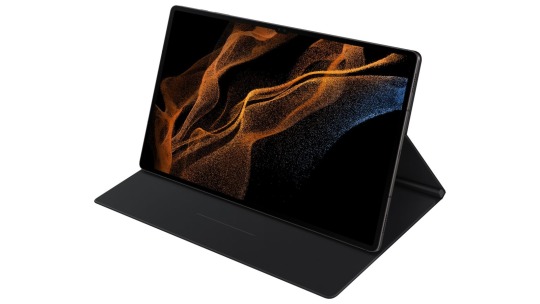
#SamsungGalaxyTabS8Ultra
#Samsung
#technology
#Android
#tablet
#Snapdragon888
#highend
#productivity
#digitalart
#creative
#batterylife
#camera
#stylus
#performance
#powerful
#storage
#RAM
#procreate
#androidtablet
#mobiledevice
#tech
#gadgets
#electronics
#mobiletech
Check out the full Vid : https://youtu.be/T8KNCflobIU
0 notes
Text










Contrast audio MODEL ONE AS-3 Reference PRO.
1 note
·
View note
Quote
We Transform
Every Home
We Touch....

#screeninnovations#120"screen#color wash#technology interiors#technologyinteriors#tech accessories#4k projector#sony 4k#home theater installation#home theater system#home theater fishers#Custom home entertainment#sweet elite#hdr#starceiling#high resolution#highend electronics#top of the world#top of the line#indianapolis#home & lifestyle#beauty#home theater enthusiasts
2 notes
·
View notes
Photo

Last minute gift idea, a @k40electronics radar detector for the commuter and or speeder in your life. #k40electronics #radardetector #christmasgifts #northpalmbeach #southflorida #highend #electronics (at Audio Props) https://www.instagram.com/p/BriZtq7gZXu/?utm_source=ig_tumblr_share&igshid=1w6cufd2oi8wi
1 note
·
View note
Photo

Custom lighting featured here is a custom version of our electron pendant using x15 electron lights suspended down 3 floors in this luxury home built by @marbleconstruction ⠀ ⠀ #karice #lighting #luxury #luxuryhome #lights #luxurylifestyle #lux #dreamhome #luxuryhomedecor #highend #custom #lightfixture #luxuryhomemagazine #dailyhive #luxuryhomes #interiors #luxuryliving #upscale #follow #luxuryinteriordesign #vougeliving #luxuryhome #luxuryhouse #luxemagazine #vouge #electron #igmansions #luxuriouslife #mansion #luxuryestate⠀ ⠀ PC @360hometours.ca⠀ Lighting consultant @v_plus_illumination_design (at West Vancouver, British Columbia)
#luxuryinteriordesign#electron#luxuryhomes#highend#luxuryliving#luxury#upscale#lux#luxemagazine#luxuryhouse#vouge#custom#lighting#vougeliving#karice#luxuriouslife#luxurylifestyle#lightfixture#lights#luxuryhomemagazine#follow#igmansions#luxuryestate#luxuryhome#dreamhome#mansion#luxuryhomedecor#dailyhive#interiors
1 note
·
View note
Text
Chord Mojo 2 Now Available, Small but Cutting Edge Tech for Portable and Home!
Hi Everyone,
So it is great to have a new product to talk about as over the last couple of years we have been starved of new releases really as everyone just tried to get through the pandemic and to be honest meet the increased demand and parts shortages that the HiFi industry has faced.
The original Mojo was a huge success for Chord, a total game changer and created a whole new genre in HiFi, a really highend portable DAC/Headamp + Pre for sensible money that sounded amazing, it actually went on to become one of our most popular products over the years, I always took mine with me when travelling.
Over the last few years since the original Mojo inception obviously things have marched on, especially in the digital DAC domain so utilising the latest FPGA technology with Rob Watts design the Mojo 2 promises to be a major leap forward for not just portable DAC's but as a DAC to use at home so I am pleased to say that we have had our first delivery with more due very soon.
Rather than me reciting Chords website please see below what the Mojo 2 offers -
The British designed and built Mojo 2 is the most advanced portable DAC and headphone amplifier in the world today.
Entirely engineered around a powerful, custom-coded FPGA processor, Mojo 2 benefits from several unique technologies.
Central to the new Mojo 2 is the world’s first lossless DSP, an advanced ‘digital tone control’ without any degradation in sound quality. The ‘UHD DSP’ gives Mojo 2 unrivalled compatibility with today’s wide-ranging headphones, plus unparalleled flexibility with partnering equipment.
A further key feature is the new menu system, navigated via the new (fourth) control sphere, bringing mute, crossfeed, button-lock and tone control adjustment.
Mojo 2 offers greatly improved battery management, with faster charging rates, a huge 75 % reduction in power loss, plus a 9 % capacity gain.
A new USB-C data input adds greater flexibility, transparency has been greatly boosted, thanks to an improved noise-shaper, lower distortion and greater neutrality, plus Mojo 2 can even be taken wireless with the Poly streamer/server.
Handmade in the UK with a robust CNC-milled aircraft grade aluminium chassis, Mojo 2 offers unrivalled performance, class-leading sound and peerless build quality.
If you'd like to come in to demo a Mojo 2 please feel free to get in touch to make an appointment.
https://hifilounge.co.uk/product-category/brands/chord-electronics/mojo/
youtube
youtube
Cheers,
Paul.










3 notes
·
View notes
Photo

Happy Friday, everyone! I hope you all had a great week. Time to back and enjoy the sweet sounds of the weekend from @thespeakershack #soundup ・・・ The wonderful sounding KEF Blade Speakers powered by McIntosh Labs electronics ❤️ #thespeakershack #music4audiophiles #kef #mcintoshlabs #blade #speakers #amplifiers #audiophile #quality #audio #highendaudio #highend #music #audiolove #luxury #hifi #hifiaudio https://www.instagram.com/p/CH0krVDpFgI/?igshid=l6yhughlozlv
#soundup#thespeakershack#music4audiophiles#kef#mcintoshlabs#blade#speakers#amplifiers#audiophile#quality#audio#highendaudio#highend#music#audiolove#luxury#hifi#hifiaudio
4 notes
·
View notes
Text
Review: Valvet Soulshine Tube Preamplifier by MGD

Marty DeWulf passed away about a month after submitting this review. His work was always an inspiration to me and it was a privilege to share his thoughts on this hobby he loved so much. RIP Marty - you are missed.
There was a time when two high-end audio companies dominated the conversation and the market regarding tube electronics. In the 1970s, Audio Research and conrad-johnson were the first, last and every word when it came to valves. There were other small tube manufacturers around, but they were basically garage-based start-ups, poorly financed with minimal budgets and little business savvy. It was a world populated by solid state and companies carrying the flag for “modern” transistor designs. It seems ironic that back in the 1970s when transistors were so predominant, they sounded their worst… the format was much less than mature.
Related Reading:
First Take Review: Valvet Soulshine Preamplifier & A4 Mk.II Amplifier
Thumbing through a current audiophile publication today, whether it be online or in the pages of a magazine, tube products abound. They come with names from companies I’ve never heard of before, and from faraway places. Go away for a few years and the scenery changes drastically… I feel so old. Fortunately, I’m still friends with @taww, who sends me stuff to listen to and write about. When I first talked to him years ago he wasn’t a fan of tube gear. If I recall, he thought valves to be totally inaccurate and euphonic sounding. [Okay, maybe that’s a little harsh, but yes I strongly preferred solid state accuracy.] I too, was a solid state guy. The dynamic range, frequency extension and clarity of modern solid state electronics have had me on their side for many years. But then, I heard the Monarchy M24 tube DAC and saw it as a true head turner with its tube section. [So did I! I bought my Monarchy NM24 review unit and it was my reference DAC for years, tubes and all.]
The Monarchy wasn’t the first great tube product in my experience. I’d reviewed a tube preamp from Musical Designs that was a budget wonder, and over the years I’d heard a number of Audio Research products that seemed to bridge the gap between reality and sonic illusion in palpable ways. [Don’t forget Audible Illusions and Joule Electra, I remember you liked those too.] Some very fine tube products had served to weaken my wall of valve resistance and solid state preference, so much so, that I would eventually purchase an all tube preamp from SAS, as did fellow BFS writer Rich Weiner. Still, when it came down to absolutes; dynamic edges, front to back transparency, frequency extension and tonal trueness, my overall preferences always lead me down the road of the better solid state units, the Pass Labs XP10 for example.
When @miy-taww suggested that I audition the tube preamplifier from Valvet certain expectations immediately arose; it’s a tube preamp after all. In certain ways, valves are valves and they behave predictably, especially basic designs such as the Valvet. He gave me a rundown of the circuit employed and the choice of tubes. A picture of the unit’s performance was forming in my head even before my ears had heard it. The Soulshine preamplifier from Valvet (USD $5,890) was unique to me in several ways. Handmade in Germany, its parts selection was insanely high with premium resistors and exotic caps in abundance, all hand-wired with solid-core silver. It looked to be a new interpretation of an old theme.
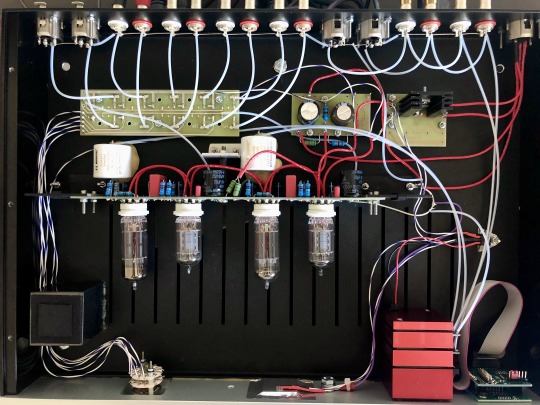
[Note: An upgraded version, the Soulshine IIz ($8,890), is now available. The original Soulshine reviewed here is still available on order for $5,890 through its US distributor, Alfred Kainz of highend-electronics.]
Design & Operation
A few words about the physical construction of the Soulshine. Like so many quality preamps before it, the Soulshine has a separate chassis for its power supply and control sections. Constructed of thicker than the usual aluminum billet, the appearance is low slung, clean and high tech. I like the way it looks. The front face, following the theme of clean futurism, has a chrome knob for the stepped-attenuator volume control and another for input selection (four line-level inputs, one of which is balanced XLR). To the right of the volume control is a window with numeric volume level displayed with blue LEDs; with one number for both channels, there is no way of setting left to right balance. The tradeoff is one less control in the signal path.
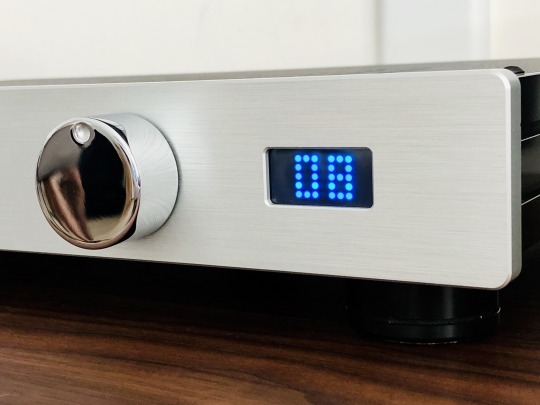
The rear panel of the preamp allows for single ended as well as balanced operation, though @miy-taww informed me that the internal circuit is not truly balanced even when using the balanced connectors. [ On closer examination, it appeared that the inverting half of the balanced signal is referenced to signal ground internally. @miy-taww ] On an operational note, I consistently had to allow the preamp about 30 minutes warm-up time at the beginning of each listening session to obtain its best.
The Soulshine has a remote control for volume changes while its listener is firmly planted in a comfy listening chair. Unlike my last experience with a tube preamp employing remote volume control, the Valvet was quiet, responsive and easy to use. This is the way a remote should be configured – simple and easy to use. The lone problem I had with operating the Valvet came from trying to find the on/off switch…. which took me an embarrassingly long time to find (hint, it’s underneath the power supply).
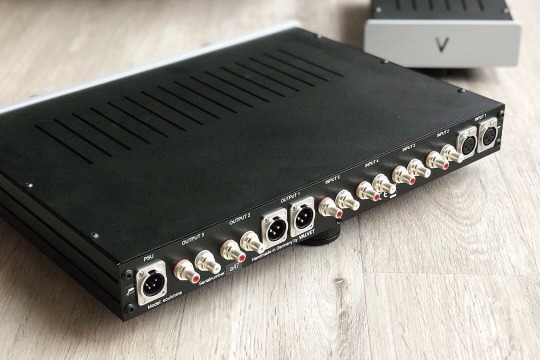
Sonics
Having a pre-established vision of what the Valvet would sound like before it even arrived, I can now report that my expectations were only partially right. First off, let me mention the output impedance of the Valvet is 400 Ohms. Because of that, the input impedance of the power amp you are using is not going to impact the sonics of the preamp substantially. What I didn’t expect were the results obtained by using amps with high, medium and low input impedances; the preamp performed consistently regardless of the amplifier used. Frequency extremes stayed relatively consistent with each amp used. That was a big surprise. What did change was stage size as I went from one amp to another. With the Pass Labs XA30.5′s lowish input impedance (30 kOhms balanced, 15 kOhms unbalanced), the soundstage was somewhat smaller and a bit laid back. Going up in impedance resulted in a nominally larger stage and slightly deeper bass response, but little else.
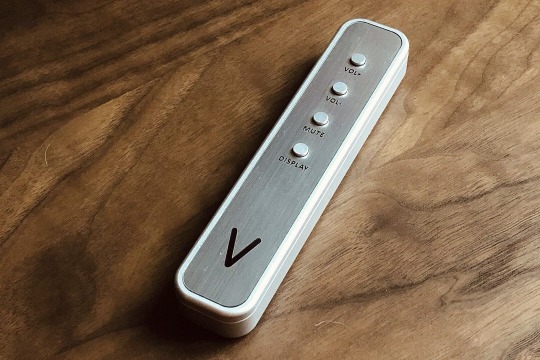
Let me talk about the Valvet with the low input impedance Pass Labs amp. I didn’t expect these two products to work well at all, but the combo proved almost hypnotic sounding as my initial auditions with the two lasted far longer than anticipated. The performance with the Pass wasn’t so much like having the instruments and singers in the room, a phenomenon I’ve come to expect with my Pass amp and preamp combo. With the Pass and the Valvet it was slightly more distant, while still being super vivid, substantial and picturesque. It was almost like listening to an aural View-Master. Remember the toy from the 60s? It has two eye holes and a lever to press that advanced a round disc with photos that presented to each eye a slightly different version of a scene, usually outdoors, that resulted in the user seeing an almost unrealistically vivid, 3D, and real appearing vista. The sense of 3D depth was stunning using the Valvet and Pass with dense color tones and detailing that resulted in a reach out and touch it quality, a rare synergy between a solid state amp with a valve preamp. It was like being there, except on a smaller scale, a scale in which reality seemed to fit on a smaller stage. The Valvet preamp with the Pass amp was very much like the View-Master. It had a superbly grainless presentation with depth and dimension galore. I thought about how photos of Yosemite in my View-Master seemed like being there one frame at a time – just smaller. Listening to Red Norvo’s, Forward Look struck me as a less-than-forward look at the performance that was in every other way as alive and dimensionally solid as my old Yosemite View-Master images.

View-Master ad, c. 1955 (source: Santa Barbara Museum of Art)
Dynamics were proportional to image size with good edge and bite, though not to the extent I expect from the best solid state preamps. Interestingly, while large bass and kettle drums when struck with the Valvet didn’t have the visceral punch of my Pass preamp, the Valvet conveyed as much big drum volume as any preamp I’ve ever heard. Going to power amps with input impedances higher than that of the Pass, such as my rebuilt Dayton Wright 500 (75 kOhms), increased the size of the soundstage, brought it forward, while causing the same to be ever so slightly less dense.
Purity. Whereas solid state preamps seem to more easily engender the quality of transparency, sometimes to the extreme, the best tube preamps in my experience have a quality I prefer to call purity. It’s a feeling thing, a sensation that one preamp feels more like “transparency” and the other feels more like “purity.” Yes, that’s a cop out. Then again, I’m not sure I’m capable of defining the two in such a manner so as to come up with a better definition of the two terms. Presently, I use transparency and purity with the understanding that with time, the two might eventually define themselves with some clarity. I fear that the difference in the two terms is more of a gut feeling rather than something clearly tangible emanating from the Webster’s dictionary. Let’s work on this.
Listening to Judy Collins “Send in the Clowns” [Tidal, Qobuz], the Valvet swims in a feeling of humanity - a female life was in the room singing in a form and fashion that highlighted inflection and elemental emotion over power or presence. Not that power and presence were not there, they were, but those qualities were subservient to the sensation of un-hyped reality; a reality formed and fashioned around the sensation of the tangible. It’s a reality that the previous tube preamp covered by me missed in total. The midrange rightness of the Valvet makes all of the exciting details of the music come to the fore, while never seeming to observe the performance through a microscope. Extreme transparency, on the other hand, not only draws attention to itself, but forces the listener, on many occasions, to focus his/her attention on aspects of the performance that are sometimes less than musical. The performance takes on less importance than the sonic fireworks used to stimulate the senses of the listener. Take your pick; the Valvet, though transparent in the best sense of the word, is more pure in its intentions and performance than almost any other preamp I’ve auditioned.

Comparing the Valvet to my Pass Labs XP10 preamp ($5,250 before being replaced by the XP12) resulted in exactly the results one might expect. These two preamps are of unquestionable quality, each passing the signal sent to it as close to perfect as one could want. But they differ, and the careful listener has no difficulty telling the one from the other. I might describe them as saying that where they converge on a singular sound, neither sounds too much like the other; they maintain their individual characters while each seeks a somewhat different though idealized vision of reality. Yes, I’ll give the frequency extremes to the Pass, even the highest highs. Gross dynamics have a small advantage with the Pass also, though it is a minimal advantage. Where they differ, and where the Valvet will have an advantage to some ears is in the area of midrange coherence and that mystery word “purity.” And while the Pass also strikes me as having a high degree of purity in its reproduction, the Valvet goes there in spades, swooping up the listener in a tsunami of musical coherence. The lens of the Valvet is one of musicality, but also of great organic texture, heart and warmth. Now, these later qualities are also found with the Pass - it too delivers a wonderfully picturesque portrayal of the performance - but the Pass tends toward back-of-the-stage “air” and transparency, and the Valvet toward purity. A logical case can be made for either preamp, and I loved listening to both, but I feel the Pass appeals more to my mind as the Valvet harkens more to my heart. Combine the purity of the Valvet with its View-Master spatial qualities, and this preamp conjures up my first memories of auditioning the original SP-10 from Audio Research, so advanced it sounded and how it stood out from other tube preamps I had heard back then.
Conclusion

If you tend toward tube preamps and yet are unwilling to live with some of their greater failings, the Valvet is a marvelous place to go. The price is not unsubstantial, but when compared to some of the more insanely priced products out there that don’t sound as good, this is a fine place to end up. Thanks to Valvet distributor Alfred Kainz of highend-electronics and @miy-taww for allowing me the opportunity to audition this marvelous device.
1 note
·
View note
Text
Best Cajon Drum Reviews

This Wood box Is. Exceptionally popular with drummers and percussionists, in addition to others. Cajon can be a tool for everybody. Regardless of whether for musical instruction or company seminars, everybody else adores the Cajon. Keep tuned in to find out more concerning the superb tool.
Exactly where Is it true that the Cajon result out of?
Even the cabin Originated from Peru and also Was first noted on paper within the mid-19th century, but dates just two centuries past. After dinosaurs who were out of Africa at the moment were prohibited from drumming so were made to search for solutions. The first cajon might have been anything as easy as an excellent fresh fruit cage. This absolutely was Paco de Lucia, '' the Spanish flamenco guitarist, that released the currently grown wood box, to Europe from the late 1970 s. As against the 90s along with also the massive tide of"MTV Unplugged," cajons grew to become famous.
Exactly why Is it true that the Cajon curiosity many men and women?
The Cajon Is Quite a functional Tool, it truly is mobile, does not use up a lot of distance and also can be relatively simple to master, or so the barrier to entry is so minimal. You may play with seated after which finding out the simple trap (higher border ) and bass sound (mid )and also the first straightforward rhythms are effectively in their own way. Having fun other drummers, jointly at an assortment, creates the entire experience more pleasurable.
What Are some frequent types?
Cm in dimension and chiefly made from walnut or beech plywood, even while a few highend units are produced with wood.
In industrial cajonsyou Possess string-cajons or even snare-canons. String Cajon have four or two guitar sequences as being a snapping part together with the rear part of the stunning surface. This version stems in Spain and also has a delicate trap result, in addition to an extremely arid general sound by having a superb bass and trap break.
For something somewhat livelier and Fantastic for drum collection hooks, look at some snare-Cajon. All these are armed using trap wires contrary to the rear of the surface that hastens if struck.
Significantly enhanced these mechanics using its caked snares over the Casela Guru versions, and also the soft and removable snares of this Schlagwerk tremendous Agile Cajons certainly are a noticeable upgrade to this very simple trap cajons.
The 3rd version of this Cajon will be Less ordinary and reflects the initial archetype. All these Afro Peruvian Cajon don't have any strings or snares indoors, and also their woody The sounds are rather popular in flamenco.
Travel-Cajons, Cajons for Kids along with Cajon kits, best cajon drums.
Recently years manufacturers Have produced a few intriguing versions, along with this abovementioned canon with conventional measurements. For kids, you'll find exclusive cajons in a more compact size.
Hybrid Cajons -- acoustic perform electronic Appears.
The Most Recent advancements blend the Cajon's acoustic noises with samples that are electronic. Underneath the magnificent outermost layer of the Roland EC-10 el-Cajon, you'll find triggers, and also to this clear guitar sign will trigger noise based on taking part in with dynamics. The Spanish corporation D-G DeGregorio has established its hybrid Cajon referred to as Centaur using about three side-mounted activate surfaces and also the prospect of minding its noises. Should you want to know more about trying out electronic sounds and currently have a Cajon, then look at Roland's EC-10M, then a solid structure using a high-value mic that readily mounts into your Cajon.
Add-ons
After travel, always? Save your Cajon at a tote. There Are Several functional and Revolutionary equipment. In the Event, You prefer your palms free to perform Different tools Or even want to play with a Cajon at a percussion installation, look at a Cajon pedal. Insert Additional sounds together with all the Heckstick one particular and also the Cajon Cabasa that Contrary to the outside to build rich seems, or play with a shaker at one hand while the Flipside performs the major.
1 note
·
View note
Photo
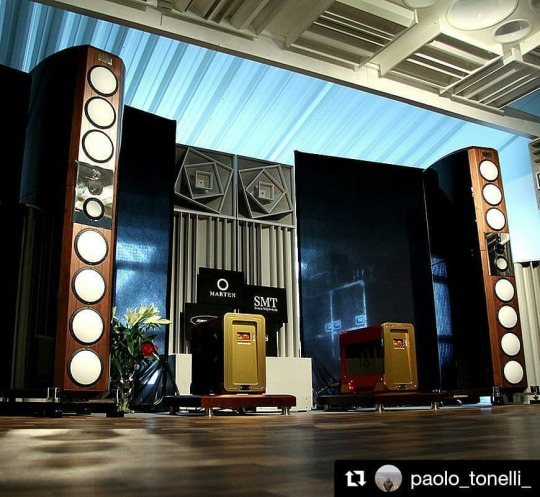
#HiEndRepost #Repost @paolo_tonelli_ ・・・ MARTEN COLTRANE SUPREME 2. POINT SOURCE LOUDSPEAKER. PAOLO TONELLI'S BEST SPEAKERS SELECTION. #paolotonelligroup #highrevolution #hyperspeakers #stradiwire #silverstarsoundcables #martencoltrane #stereophile #luxury #audiophile #sound #audio #instahifi #tweeter #highendshow #highend #audioporn #hifiporn #subwoofer #tubeamplifier #hiendrepost #hifiaudio #dolbysurround #hometheater #preamp #preamplifier #subwoofer #components #electronics https://www.instagram.com/p/B45U-eRoV1E/?igshid=1wilm33revacl
#hiendrepost#repost#paolotonelligroup#highrevolution#hyperspeakers#stradiwire#silverstarsoundcables#martencoltrane#stereophile#luxury#audiophile#sound#audio#instahifi#tweeter#highendshow#highend#audioporn#hifiporn#subwoofer#tubeamplifier#hifiaudio#dolbysurround#hometheater#preamp#preamplifier#components#electronics
3 notes
·
View notes
Text




Contrast audio LENS. Made in Ukraine. Since 1996.
#highend#hifi#electronics#audiophile#luxury#audio#contrastaudio#music#book shelf loudspeakers#contrast loudspeakers#contrast audio loudspeakers#high end loudspeakers#loudspeaker
0 notes
Photo

We are Authorized Dealers and installers of @k40electronics radar detectors. Get your Drive Ticket Free Guarantee from K40. Drive in peace knowing you are protected or give the gift of ticket-free guarantee. Come in or call 561-328-6329 #safedriving #christmas #giftideas #northpalmbeach #palmbeach #jupiter #jupiterflorida #tequesta #palmbeachgardens #highend #electronics (at Audio Props) https://www.instagram.com/p/B58oik9ptbJ/?igshid=f0vp6kgr3r56
#safedriving#christmas#giftideas#northpalmbeach#palmbeach#jupiter#jupiterflorida#tequesta#palmbeachgardens#highend#electronics
0 notes
Photo

We had a great day @regaresearchuk last week and were super-impressed by their obsessive quality control. It’s no wonder #Rega turntables and electronics sound so good. #highend #hifi #speakers #hifiporn #audiophile #instahifi #luxury #highendaudio (at Southend-on-Sea) https://www.instagram.com/p/BwW0XjzDChU/?utm_source=ig_tumblr_share&igshid=6nit4wcjwms6
1 note
·
View note
Photo

Chord Electronics Ultima 2 Reference Mono Amplifiers Now On Demo!
Hi All,
I have to say we are going through an embarrassment of riches at HiFi Lounge at the moment as 2020 has started with some awesome new kit on demo and there is still plenty more to come but I have to say having the new Chord Ultima 2 amplifiers on permanent demo is very special indeed as we are the only place to have them on demo in the UK, a real statement piece, but first I should apologize to Chord for using a rivals DAC with their amps at the moment, ideally I’d be using a DAVE + Scaler but mine are out on loan at the moment and as I was so keen to post the news about the new amps we had to go with what we had here, so sorry Chord, Dave will be back on the rack shortly.
Anyway back to the amps, firstly I was quite shocked at their size when I first opened the flight case, yes they come double stacked in a heavy duty flight case, that certainly makes a statement before you even start, I decided to go with the black side inserts rather than the more tradition Chord in-built leg design and I am really glad I did as I think they really do look epic like this, we then lifted them into place in their new home and fired them up, WOW and WOW again, Chord really know how to make a statement, they just look incredible, it dawned on me the other day that in the UK we really don’t do much in the way of Highend Audio, especially amplification, but Chord are certainly flying that flag proudly with their Ultima range.
It is nice to make a statement with your kit but in reality the only thing that matters is the sound quality and these new Ultima amps are a total redesign of Chord’s amplifier typology and I would say they have created something very special here as we have hooked them up to our PMC Fenestria’s, now these are a brilliant speaker but they really do appreciate an amp with plenty of current and I can honestly say that I have never heard them sound as good as they do with the Ultima’s driving them, they really do get hold of the speaker giving a really tight and controlled sound but they also have a delicacy and articulation that is quite captivating, when I first powered them up one evening I really did struggle to go home as I kept going from track to track, have to say Halo by Machine Head was mind blowing, for me they are an amp that can do everything from great insight with vocals to controlled powerful bass on rock which needs to be turned up to 11, awesome job Chord.
Now they do cost £18,000 each so they should be good but the good news is that Chord are now putting the Ultima Tech into 2 new stereo versions starting around £6k which is obviously a lot more attainable, anyway our new Ultima 2’s will be on permanent demo and always on ready for action so if you’d like a listen anytime please do pop in an be prepared to be impressed.
Please find a link below to the Chord Reference range on our website and a few pictures.
https://hifilounge.co.uk/product-category/brands/chord-electronics/chord-electronics-reference/
Cheers,
Paul.
1 note
·
View note
Text
First Take Review: Valvet Soulshine Preamplifier & A4 Mk.II Amplifier
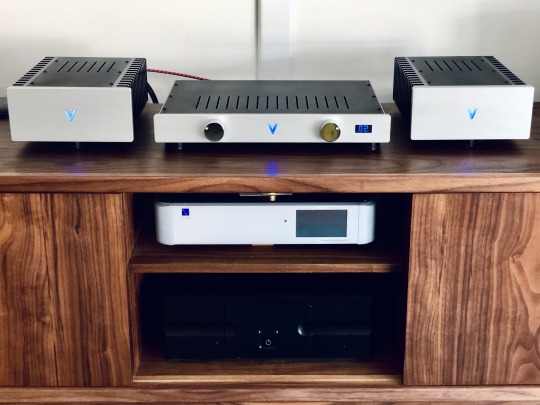
I stumbled upon the Valvet brand fairly randomly. Looking back at my original email to Alfred Kainz of highend-electronics, Valvet’s US distributor, it appears I caught wind of the niche German marque via a review of their E2 amplifier ($2,990) on 10audio.com. In it, Jerry Siegel compared it with some very well-respected solid state and tube competition - Pass, First Watt, Cary - and came away smitten with the musicality of the little 20-watter. I perused the rest of the Valvet line and was immediately drawn to how it blended sleek, unassuming styling with a focus on tried and true design approaches. Tube preamps with solid state amps (no Class D in sight), super quality passive parts, minimalist Class A and single-ended topologies, all in urban-lifestyle friendly packaging... Valvet was speaking my language. The relative obscurity of the brand (at least here in the States) and lack of online reviews only added to the intrigue. A review was clearly in order, and Alfred was kind enough to oblige us with the Soulshine tube preamp ($5,890 in the configuration we received) and A4 Mk.II monoblock amplifier ($7,890).
Alfred provided this description of the company:
Valvet is located in Bargteheide, in the north of Germany, near Hamburg. What we have here is a very consistent vision by designer Knut Cornils in design and execution. Knut founded the company in 1991 and has been building Class-A amps since 1982. Knut has evolved a distinctive architecture of Class-A modules using high-quality components in minimal designs, featuring valve pre-amplifiers with separate power supply and solid-state mono-block power amplifiers.
Valvet Soulshine Tube Preamp ($5,890)
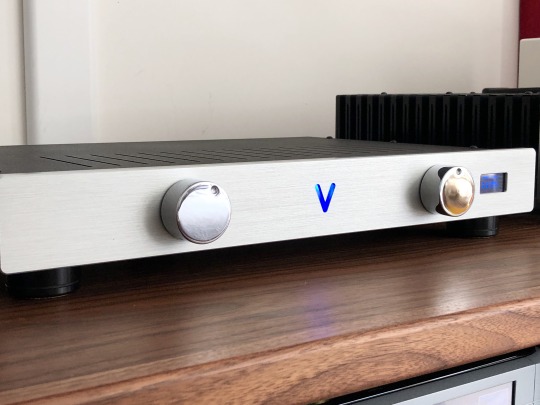
The Soulshine is Valvet’s top preamplifier line and comes in a number of configurations. The model we received is a line stage and includes a compact external power supply and stepped attenuator with remote control. Recently, two further upgrades became available: the Soulshine IIz ($8,890) featuring a dual-mono external supply, and the Soulshine Trio ($10,990) with built-in phono stage and quad supplies. @mgd-taww has the full review of our base configuration coming out imminently, but I'll share some observations from my time with the unit.
I really dug the sleek look of the Soulshine - super slender, with a minimalist front panel sporting two polished chrome knobs, a 2-digit volume display and the Valvet "V" softly glowing in blue. There's zero panel markings, which makes input selection a bit of a guessing game, and slightly odd is the fact that the free-spinning volume knob (it's a rotary encoder for the electronically-controlled attenuator) has a dimple to indicate position, despite it being completely uncorrelated with the actual volume setting. The attenuator itself works extremely well - volume control is a bit on the coarser side, definitely not 1dB across the range, but adjustments are quick, smooth and noiseless other than the gentle clicking of the internal relays. Best of all, the outputs are quickly muted to eliminate any possibility of transients on power-up or turn-off which can be a real hazard with tube designs. The back-panel features 4 inputs - 2 balanced XLR, 2 unbalanced RCA - and both RCA and XLR outputs. The power supply is external, connected with a light, flexible and detachable umbilical cord. Under the hood, the circuit is simple and the parts are high quality, with relatively neat hand-soldered point-to-point wiring (Teflon-sleeved silver in our model). Like any tube component, it'll need some room to breath, but it generates a fairly moderate amount of heat and will fit in shelves with less clearance than typical tube pre's with tall chassis and upright tubes.
Tonally I found the Valvet to be fairly nondescript, and I mean that in the best possible way. There is just a hint of extra juice in the mid-bass, and the low end isn't as extended and tightly-controlled as the solid-state Bryston BP-17 Cubed ($4,500), but otherwise things felt quite neutral and in order - another example of the convergence of tube and solid state tonality over time. The top end had clarity and extension and there was neither the upper-midrange forwardness nor the rolled-off treble that one sometimes gets with tubes.
What it did have was a uniquely singing tone in the midrange that made it particularly expressive with soft melodic passages. E.g. on a performance of the Rachmaninoff Romance by cellist Alicia Weilerstein [Tidal], a passionate rendition of the theme is followed by a pianissimo echo. Through the Soulshine, the delicate passage sounded wonderfully quiet and intimate, yet still expressive; on the Bryston it came across a bit threadbare and pale. Every once in a while this could also come across as a bit of thickening, like just a dash too much cornstarch in the sauce - e.g. with Magdalena Kozena's Mozart arias, the ethereal floatiness of her voice came across slightly more opaque than I heard with the Pass Labs XP10. Tradeoffs, tradeoffs...

Bryston BP-17 Cubed, Valvet Soulshine and Pass Labs XP10 locked in battle
I (or more accurately, my wife and I) heard a bit more editorializing going on with harmonics and timbre. One late evening I was playing some tunes on the Soulshine, Beethoven Symphony No. 2 to be precise, and my wife commented that the orchestra sounded rather sharp (pitch-wise) and nasal. Normally this is how American woodwind players describe European ensembles (who do indeed tune their A's higher and use totally different technique, reeds and often instruments). But in this case, it was a Montreal Symphony performance which she never previously commented on sounding particularly European. Switching back to one of the solid state pre's (the Bryston or Pass XP10) restored the expected timbre - her ears are particularly sensitive, and I can only surmise she was picking up on harmonic distortion being introduced by the tubed Soulshine. I could hear it as well, but to me it was pretty mild, and probably 99% of people won't notice it to the same degree.
The other area where THD may be coming into play is soundstaging. The Valvet has a healthy dose of that holographic tube feel, suspending instruments across a deep, airy and three-dimensional space... so much so that my wife actually felt the sound to be “too 3D,” something I doubt you’ll ever hear an audiophile say. Nelson Pass under his First Watt enterprise shared a design for a very simple 2nd-order harmonic distortion generator, called the H2, as a fun way to add some color to sound. He made this interesting observation about the phase of such distortion:
So why is the phase important? Well, it's a subtle thing. I don't suppose everyone can hear it, and fewer particularly care, but from listening tests we learn that there is a tendency to interpret negative phase 2nd as giving a deeper soundstage and improved localization than otherwise. Positive phase seems to put the instruments and vocals closer and a little more in-your-face with enhanced detail.
My sense was that the Soulshine adds more of the “negative phase” second harmonic - it has that deep holographic stage, without sounding up front and “technicolor” as some tube designs are wont to. Again, to my wife’s ears this effect sounded a little phasey and unrealistic, but I’m guessing many audiophiles will eat it up.
Some other notable and positive aspects of the Soulshine... it's extremely quiet, with nice black backgrounds. In fact, I found it to be nearly dead silent even when cranked to max volume, and considerably quieter than the Bryston which always had some level of audible hiss. Dynamics were strong, the Bryston capturing big hits in the bottom end with more slam and edge, the Valvet otherwise having more verve and nuance - piano in particular had great weight and presence on crescendi. There was a sense of ease, with plenty of headroom even on the loudest, most cacophonous orchestral passages, though I did find dynamics varied a bit with the volume setting, a likely consequence of placing the attenuator after the tube gain stages thus creating variable output impedance. Separation of instruments was excellent - whether listening to a small chamber ensemble or symphony orchestra, tonally-adjacent voices like viola vs. second violin came through with clarity and color. And while lesser preamps can blur the region below middle C (262Hz) into a bit of a soupy blend, the Soulshine clearly distinguished the lower registers of the cello from the left hand of piano accompaniment on sonatas.
All in all, the Soulshine struck me as a lovely and enjoyable preamp. Musically expressive and pure, it was significantly more engaging than the Bryston BP-17 Cubed, and made for an interesting counterpoint to the Pass Labs XP10 ($5,250 before being replaced by the XP12). I didn’t mention the Pass so far as @mgd-taww also uses the XP10 as his reference preamp, so I’ll let him do the honors of an in-depth comparison in his coming review.
Valvet A4 Mk.II Class A Monoblock amplifier ($7,890)
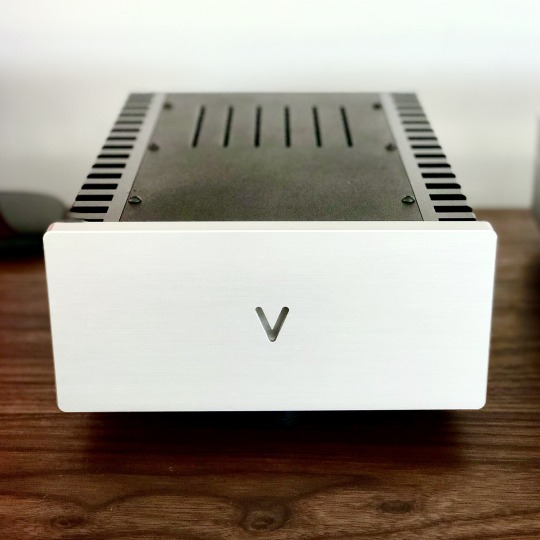
The A4 represents the 2nd generation of Valvet’s original Class A monoblock design, the A3.5. This latest “Mk.II” iteration includes 33% larger power transformers (400W), more filtering (132,000µF each!) and upgraded parts throughout including audiophile-brand resistors and cotton-insulated silver wiring. Allegedly this brings the performance of the Mk.II closer to Valvet's flagship A4e ($9,890), a souped-up 4-chassis model with larger external power supplies and a bit more power. Despite the Class A design, the A4 is downright petite, each monoblock measuring just 230 x 110 x 310 mm (9 x 4.4 x 12.2 inches) but feeling hefty and solid - I don’t have the weight on me, but you’ll definitely want to firmly grasp each one with two hands. Power is rated at 55 watts/8Ω, 90 watts/4Ω in full Class A operation. In what seems to be a new craze (Pass Labs XA25 and models from GamuT come to mind), the output stage uses a single pair of high-power transistors per channel, and the signal path is direct-coupled with no global negative feedback.
My first night with the A4 ended in disaster. I still don't know what happened - my best guess is a wire got crossed in the hookup to my REL T-9 subwoofer - but upon powering up one of the monoblocks, sparks, a small flame and smoke ensued. Clearly something shorted out somewhere, and the A4 being a true minimalist design with zero protection circuitry means any mishap can end in catastrophe. Fortunately no human, animal or other device was harmed, but after weeks of anticipation to hear the amps, I was heartbroken. In my desperation, I listened a bit to one speaker through the other functioning amp, just to get a taste... and even from that crippled mono reproduction, I could already tell there was something very sweet and special about the A4, which made my misfortune even more agonizing.
Alfred Kainz was extremely understanding and had the amps shipped back to Knut @ Valvet for repair. A while later I got them back, and this time I completely steered clear of the REL hookup, instead feeding the subwoofer from my preamp just to be safe. The amps have worked absolutely flawlessly since so the only lesson here is to be extremely careful setting them up, which the manual also states very clearly...
With that out of the way... I think these are some very special amps. While I've heard Class A amps plenty of times in other systems, it's my first time having one in my own, and it was easy to hear from the first notes what all the fuss is about. There's a purity and density of tone, a freedom from electronic haze and grain, a fluidity of expression that's subtle in absolute terms but significant in visceral ones. Great Class A amps have given me the feeling of emancipating music from the chains of typical solid-state limitations, making Class AB (and certainly Class D) designs sound synthetic and mechanical by comparison. The Valvet is delightfully expressive, sweet and pure, with an honest and unforced way of capturing the warmth and beauty of a performance. The Bryston 4B Cubed, a 300W Class AB powerhouse, impressed me with how it carried some of these lovely qualities to a surprising degree, but the Valvet communicates with a higher level of musical connection and tactile presence.
At times, I've heard Class A amps come off a bit dark and slow vs. a very transparent Class AB design. I hear no such issues with the Valvet - in fact, it has all the speed of the Bryston 4B3, with even more dynamic alacrity and nuance. Twists and turns of a phrase are conveyed with uninhibited momentum. Its highs are as sweet and refined as I’ve heard in my system, but with no sacrifice of brilliance. Vocals have richness and complexity, and the variegated harmonics of the violin and oboe have startling trueness. And while it doesn't have the big Bryston's bass slam and depth, it still packs plenty enough wallop to be satisfying with rock and electronic fare. The Mk.II upgrades included a significant stiffening of the power supply, seemingly to good effect - close your eyes, and you would never guess you were listening to an amp rated at just 55 watts. It's by no means a current monster so I would stick with at least moderately-efficient speakers that don’t dip too low in impedance, but I’ve heard 150-watt amps that don’t have this level of control and explosiveness. Certainly compared to a 60-watt integrated like the Ayre AX7e or Bryston B60, the Valvet sounds like a powerhouse.

I'll have much more to say about this wonderful amplifier in the coming months. One of the things I'll need to work on is getting some good comparisons on hand (the Pass XA25 and XA30.8 come to mind). And I have a much larger, 3.5-way reference speaker on order which will stress the Valvet's drive and current capability far more than my current 2-way monitors. In the meantime, if you value beautiful, engaging yet truthful reproduction, I strongly recommend an audition of the Valvet A4 Mk.II - it's captivated me enough to earn a long-term home in my system.
2 notes
·
View notes
Photo

I can still remember my first time hearing this CD. I was walking into the late, lamented Audio Den and hearing this wonderfully live sounding music playing back in the “big” room (the room reserved for serious buyers). I remember asking owner Bob what it was as was. He shepherded me inside (a rarity back then) and let me listen. I think it was conrad/johnson electronics playing through Vandersteen speakers and I was enchanted. Fortunately Bob had copies of the CD on hand, so naturally I picked one up. And while it’s never quite sounded as good as it did that day (nothing ever does the second time around), it’s still a damn fine recording on the Reference Recordings label. Features Mike Garson backed by, on various cuts, the likes of Stanley Clarke, Gary Herbig, Jim Lacefield, Billy Mintz, Peter Sprauge, and Jim Walker. Just good old straight ahead jazz played by true professionals who know their business. I love the five trio tracks with Garson, Clarke and Mintz. Recorded in 1986 by “Professor” Keith Johnson on HDCD (which only now with my Oppo 105D can I take advantage of), one didn’t hear Stanley Clarke play acoustic jazz often, so this was a real treat to this big Clarke fan. It still sounds fresh today - as classic often do. My system, as it’s set up today, comes as close as I’ve ever heard to reproducing the wonder of that first time. There is an LP of this album out there for those willing to look for it, but don’t pass on the CD. It’s pretty good too. Very highly recommended. #cd #jazz #music #album #stereo #digital #audio #highend #audiophile
5 notes
·
View notes